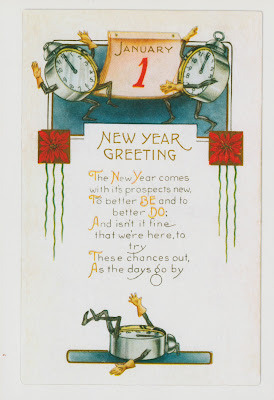New Year greeting postcard, ca 1920s
Happy New Year 2023!
The two unused postcards shared this week are reproductions of undated artwork reprinted by a small local company, Laughing Elephant. The card above has clocks and a calendar as the featured items, things that are typically associated with the changing of the year. The design look like late 1920s or possibly early 1930s style.
Greeting cards, individually handmade first, then later commercially printed, have been a tradition for centuries. In the 1400s homemade greetings were sold and exchanged in Europe. Early German cards were made using woodcuts. The two most likely holidays to exchange cards were wishes for a happy, prosperous New Year and romantic love cards for Valentine’s Day. Valentines often had lace filigrees applied to the designs.
Advances in printing provided a way for cards to be reproduced at less cost and in 1840 the Black Penny stamp allowed cards to be mailed rather than hand delivered and increased the popularity of the cards.
Sir Henry Cole, of England, created the first commercial Christmas card in 1843. Finding that his Christmas greeting list had grown longer each year, Cole wanted to reduce the time and effort it took to make individual cards. He chose three scenes to celebrate Christmas: a family gathering; the charitable acts of clothing the poor; and feeding the hungry. He had 1,000 copies of the cards printed in black and white, then hand painted. After Cole had used all the cards he needed, he sold the rest at 6 pence each. Thus, began commercial Christmas card. In those days the cost of 6 pence still made the cards a luxury item that would not have been affordable for working class people.
This second card is similar to the first one in that it has a verse and the wish for a Happy New Year. It shows a girl sitting on a list of resolutions and paddling with a quill pen, the ink pot floating in the water just ahead of her.
New Year greeting postcard, ca 1920-1930s
The practice of making promises or resolutions at the beginning of the year also comes to us from centuries ago. It was a religious activity for the Romans to make promises to their god, Janus, for whom the month of January takes its name. Medieval knights took “peacock vows” at the end of the Christmas season to re-affirm their commitment to chivalry. There are parallels in many different religions. The concept is to reflect on self-improvement annually. To offer and seek forgiveness, or to pledge a personal sacrifice as a way to improve one's self.
The diary of Anne Halkett in 1671, includes what we think of as a traditional writing down of New Years’ resolutions. She lists a number of religious pledges and writes, “I will not offend anymore.” In 1813 a Boston newspaper published the phrase: “new year resolution,” that took hold and has been used ever since. Despite all the good intentions, roughly only 10 to 12 percent of people who make New Years’ resolutions actually keep them. The others either forget or do not keep track of them. Some people say they make too many resolutions to keep track of and work on all of them. Fortunately, when the next new year comes around we have another opportunity to make resolutions if we so choose.
For additional information, see:
https://www.penheaven.com/blog/history-greetings-cards
https://www.merriam-webster.com/words-at-play/when-did-new-years-resolutions-start
https://en.wikipedia.org/wiki/New_Year%27s_resolution


No comments:
Post a Comment